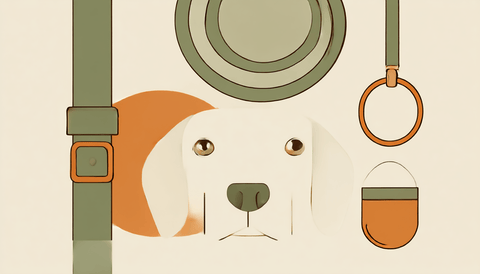Isn't this weather lovely?
It feels like the perfect temperature right now – not too hot and definitely not too cold. This warm spring sunshine feels like a much-needed reward, especially after weeks of cold days, wet shoes, and slipping about on muddy paths.
Springtime is also ideal for spending as much time as possible outside with your dog – perfect for your everyday dog walking, and maybe even trying out some fun new adventures together.
Why Springtime Dog Walking is Essential
Especially now during springtime, regular dog walking is incredibly important, benefiting both your dog's body and their mind.
This lovely springtime weather makes it easier to get out and about for that essential dog walking, providing the physical activity they need to stay fit, keep a healthy weight, and stop them from getting bored or restless at home. While the amount of exercise needed during a dog walking session varies depending on their age, breed, and general health, every single dog benefits from getting out daily, and springtime is a great motivator.
But dog walking offers much more than just physical exercise. It's also brilliant for keeping their minds busy and engaged, especially during springtime when the air is full of fascinating new smells emerging after winter. When you're out dog walking, your dog gets to experience all sorts of new sights, sounds, and smells! They're naturally curious, and a walk is a great chance for them to explore and sniff around, which they love doing.
If they don't get walked often enough, pets can sometimes put on weight, become bored (which might lead to unwanted behaviours), or develop other health problems. Actually, preventing pet obesity – which is a very common concern nowadays, is one of the key reasons daily walks are so essential.
And it's good for us owners, too! Multiple studies have found that walking the dog helps us get fitter, as people often walk further and more regularly when they have a dog encouraging them along. Making time for that daily walk really should be part of every dog owner's routine.

More Reasons to Walk Your Dog This Spring
One of the great things about walking is that it's generally gentle exercise, easy on the joints for both you and your dog, making it ideal for enjoying the lovely springtime. And if you want to push yourselves a little more, adding in the occasional hill will certainly get your heart pumping.
Regular dog walks like this can help lower blood pressure and build up muscle and bone strength, benefitting both you and your pet! And depending on their breed and energy, most dogs are more than happy to be your walking partner once or twice a day.
Getting out for a walk with your dog has also been shown to help reduce stress and boost feelings of happiness, again, for both owner and dog. The wonderful, non-judgemental company and affection our pets give us are known to be really good for our mental health, often helping owners feel a little more confident as well.
Another great thing about dog walking, particularly in spring, is that it's a fantastic way to meet people, as your dog often provides an instant, easy way to start a conversation! I remember a neighbour from a few years back who had a magnificent black Dobermann. The dog was incredibly friendly and outgoing, much more so than his owner, who was quite shy and reserved. This sociable Dobie would happily greet everyone he met, pulling his hesitant owner along.
Soon enough, the neighbour became quite well-known locally thanks to his loveable dog. It was the dog who helped him break the ice, start talking to people, and eventually make some lasting friendships. It was a wonderful partnership that definitely helped bring the owner out of his shell.
How Often Should You Walk Your Dog?
How often and for how long should you actually walk your dog? Well, that really depends on your dog – you need to consider their health, size, age, and breed, all play a part.
As a general guide, trying for at least one walk a day, lasting somewhere between 30 minutes and an hour, is a good target for most dogs. Having the right dog walking gear, such as a comfortable hands-free lead and perhaps a waterproof coat for you both, makes it easier to get out consistently whatever the weather!
Of course, some dogs, particularly very energetic breeds or younger pups, might need a lot more activity than this. On the other hand, older or less active dogs might be perfectly happy with just a shorter walk around the block.
It's also worth remembering that walks aren't the only thing that benefits your dog. Playing fetch in the garden, using interactive and enrichment toys indoors, and other fun games are brilliant ways to add variety to their exercise routine.
What's most important is to give your pet a good balance of physical exercise and mental stimulation to keep them in great shape, both physically and mentally.

Planning Your Springtime Dog Walking
Having a plan for your walks can make a big difference. If walks are completely unstructured, things can get a little chaotic – nobody wants to be the owner whose dog disappears the moment the lead is off, only showing up again when they feel like it!
But one of the best things about walks is the freedom your dog gets to enjoy. Thankfully, you can have both freedom and a little structure with some simple planning.
A good starting point is leaving the headphones behind and giving your phone a rest while you're walking. This is quality time for bonding with your dog, and they deserve your full attention; whatever else is going on can probably wait.
Right at the start of the walk, your dog will probably want to have a sniff and relieve themselves. It's best to let them do that first before trying to get their full attention. After that, letting them have a good five minutes or so just sniffing around is great, because it's how they find out who or what has been in the area recently.
This initial exploration can be off-lead if your dog has a reliable recall and stays reasonably close. But if you can't quite trust your dog to stay close yet, or if they're easily tempted to run off, it's safer to leave the lead attached for this initial exploration.
If you do want to try off-lead with a dog who might dash off, here’s a helpful tip: before you unclip the lead, have a tasty natural treat ready in your hand. Get your dog’s attention and then throw the treat on the ground just behind you. This encourages them to see staying near you as rewarding, rather than immediately running off to find their entertainment.
For a satisfying spring walk for both of you...
Try to include a mix of activities. Spend some time actively training or practising commands they already know. Make sure there's enough time for them just to be a dog – exploring their surroundings, sniffing all those interesting smells, having a little run, and generally relaxing at their own pace.
Finally, try to finish the walk with about 15 minutes of calm, steady walking to help them wind down before you get home.
We recently wrote a blog about Dog Walking Gear Every Owner Needs for Spring, which may be worth a read if you need help choosing the best spring gear.



